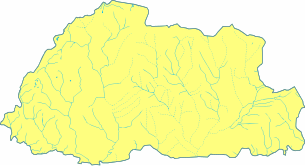
Back Επαρχίες του Μπουτάν Greek Provincias de Bután Spanish Bhutans provinser NB Провинции Бутана Russian
The Provinces of Bhutan were historical regions of Bhutan headed by penlops and dzongpens (both translated as "governor"). Provincial lords gained power as the increasingly dysfunctional dual system of government eventually collapsed amid civil war. The victorious Penlop of Trongsa Ugyen Wangchuck gained de jure sovereignty over the entire realm in 1907, marking the establishment of the modern Kingdom of Bhutan and the ascendancy of the House of Wangchuck. Since this time, the provinces of Bhutan have been reorganized several times into what are now the twenty Districts of Bhutan (Dzongkhag). Provincial titles such as Penlop of Trongsa and Penlop of Paro carry on, however, wholly subordinate to the Royal House.[citation needed]
Traditionally, Bhutan comprised nine provinces: Trongsa, Paro, Punakha, Wangdue Phodrang, Daga (also Taka, Tarka, or Taga), Bumthang, Thimphu, Kurtoed (also Kurtoi, Kuru-tod), and Kurmaed (or Kurme, Kuru-mad). The Provinces of Kurtoed and Kurmaed were combined into one local administration, leaving the traditional number of governors at eight. While some lords were Penlops, others held the title Dzongpen (Dzongkha: རྗོང་དཔོན་; Wylie: rjong-dpon; also "Jongpen," "Dzongpön"); both titles may be translated as "governor."[1]
- ^ Madan, P. L. (2004). Tibet, Saga of Indian Explorers (1864–1894). Manohar Publishers & Distributors. pp. 77 et seq. ISBN 81-7304-567-4. Retrieved 2011-08-14.
